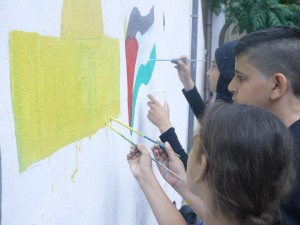LEAP volunteers will work in the Palestinian refugee-camps of Lebanon. LEAP currently operates in the following four refugee camps in Lebanon: Bourj el Barajneh and Shatila in Beirut and Bourj el Shamale and Rashidieh in Tyre.
Beirut Camps
Bourj el Barajneh
 Bourj el Barajneh refugee camp was established in 1948 by the League of Red Cross Societies. The majority of its residents fled from Galilee in northern Palestine. Bourj el Barajneh is the most overpopulated camp in Beirut. Its residents are in dire poverty and live in destitute conditions. The camp has narrow roads, an old sewage system, and experiences frequent flooding during the winter season.
Bourj el Barajneh refugee camp was established in 1948 by the League of Red Cross Societies. The majority of its residents fled from Galilee in northern Palestine. Bourj el Barajneh is the most overpopulated camp in Beirut. Its residents are in dire poverty and live in destitute conditions. The camp has narrow roads, an old sewage system, and experiences frequent flooding during the winter season.
Men from the camps frequently work as casual laborers in construction and women work either as cleaners or in sewing factories.
The camp is located in the southern suburbs of Beirut in close proximity to the Beirut International Airport.
Statistics
- More than 16,000 registered refugees
- Seven schools
- One health center
- Active senior citizens home
- Job counseling and placement center
Shatila Refugee Camp
The International Committee of the Red Cross created the Shatila camp in 1949 to accommodate refugees that were exile from Amka, Majed al-Kroum and al-Yajour area villages in northern Palestine after 1948.
The camp also faced frequent devastating attacks and damage during the 1982 Israeli invasion in Lebanon, the Lebanese civil war, as well as the camps wars. In addition, the Sabra and Shatila massacre is one of the greatest tragedies that occurred to refugees in Shatila and its legacy still lives on today. There are still destroyed buildings in the camp and remnants of war that remain.
The majority of men work as laborers or run grocery stores, and women work as cleaners.
The Shatila camp faces dismal environmental health conditions; shelters are damp and overcrowded, and many have open drains.
Statistics
- More than 8,500 registered refugees
- Two schools
- One health center
Tyre Camps
Bourj el Shamale
Bourj el Shamale camp, which lies just 3km east of Tyre city in south Lebanon, was established in 1948 to provide tented shelter for refugees from Hawla and Tiberias in northern Palestine. In the following years, the camp also became a refuge for residents from other camps in Lebanon during times of hostility.
 The camp also suffered a great deal of damage during the Lebanese civil war and still requires significant improvement of its infrastructure.
The camp also suffered a great deal of damage during the Lebanese civil war and still requires significant improvement of its infrastructure.
The majority of shelters were built with concrete blocks, however, there are still many makeshift shelters with zinc roofing. Unemployment is extremely high. Most men find work in seasonal agriculture, construction and manual work. Women work in agriculture and as house cleaners.
Statistics
- More than 19,500 registered refugees
- Four schools
- One health center
Rashidieh Refugee Camp
 Rashidieh camp lies only 5km from Tyre and was built by UNRWA in 1963 to accommodate refugees evacuated from Gouraud camp in the Baalbek area of Lebanon. The majority of its residents’ origins stem from Deir al-Qassi, Alma an-Naher and other villages in northern Palestine. However, the camp was originally built in 1936 by the French government for Armenian refugees who fled to Lebanon.
Rashidieh camp lies only 5km from Tyre and was built by UNRWA in 1963 to accommodate refugees evacuated from Gouraud camp in the Baalbek area of Lebanon. The majority of its residents’ origins stem from Deir al-Qassi, Alma an-Naher and other villages in northern Palestine. However, the camp was originally built in 1936 by the French government for Armenian refugees who fled to Lebanon.
Rashidieh camp was heavily impacted by the Lebanese civil war, particularly between the years of 1982 and 1987. During that time period, approximately 600 shelters were completely or partially destroyed and over 5,000 refugees were displaced—yet again. The remaining shelters are still in need of serious rehabilitation.
Employment opportunities are very limited. Most residents work seasonally in agriculture and construction.
Statistics
- More than 27,500 registered refugees
- Four schools, including one secondary school
- One health center
El Buss Refugee Camp
El Buss refugee camp is located 1.5km south of Tyre.
The French government originally built the camp in 1939 for Armenian refugees. Palestinians from the Acre area in the Galilee came to el-Buss in the 1950s and the Armenians were moved to the Anja area.
Because of its relatively small size and location, the camp was spared much of the violence that other camps experienced throughout the Lebanese civil war.
The residents of El Buss generally work in seasonal agricultural and construction.
The camp’s inhabitants live in concrete block shelters, some of which were built by the refugees themselves. The water, sewerage and storm water systems were rehabilitated between 2007 and 2008.
Statistics
- More than 9,500 registered refugees
- Four schools
- One health centre
Source: UNRWA Lebanon (http://www.unrwa.org/etemplate.php?id=73)









